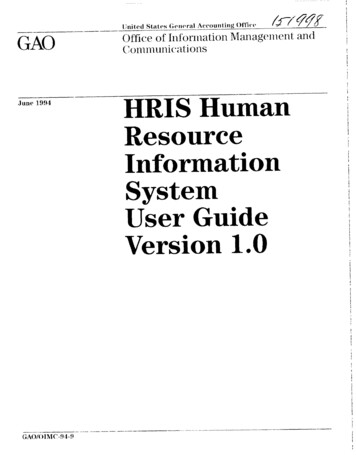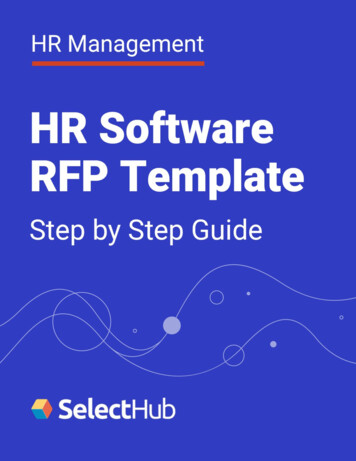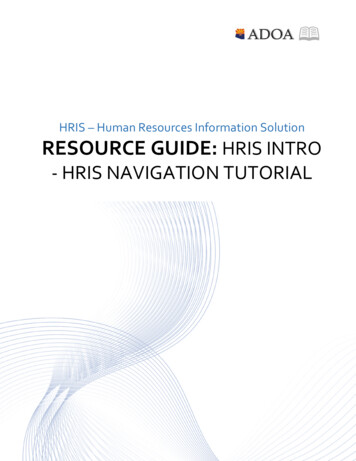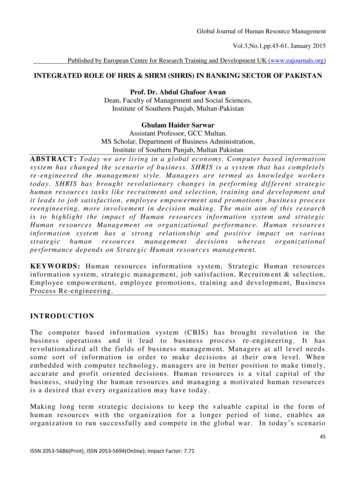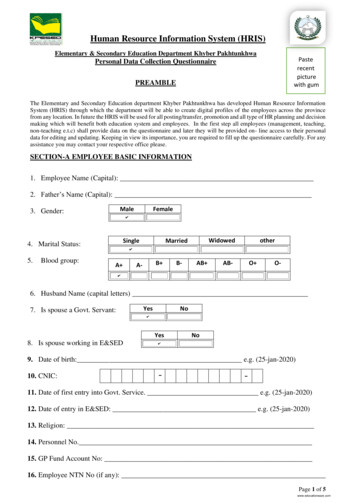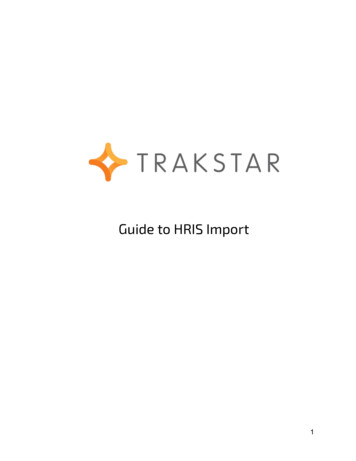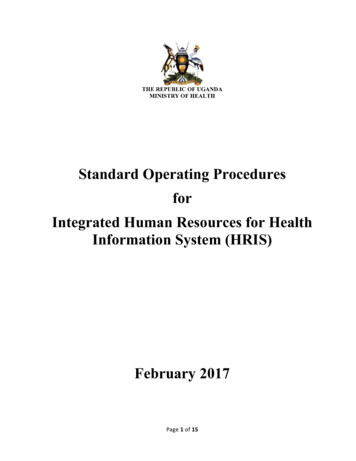
Transcription
GIAN JYOTI E-JOURNAL, Volume 1, Issue 2 (Jan – Mar 2012)ISSN 2250-348XHuman Resource Information Systems (HRIS) - Its role and importance inBusiness CompetitivenessDr. Nisha Aggarwal1, Mona Kapoor2AbstractEmerging hyper-competitive era in the last few decades has increased the need ofinformation system and technology in human resource management for competitiveness. Therevolution in information technology is completely and swiftly redefining the way things aredone in nearly every field of human activity. Human resources and information technologyare two elements that many firms are looking to utilize them as strategic weapons tocompete. Information systems especially developed for human resource management referredas human resource information system (HRIS) is an integrated system necessary to collect,record, store, manage, deliver and present data for human resource and hence promoteseffectiveness of human resource system. Human resource technology or human resourceinformation system shapes an interaction between human resource management andinformation technology. There has been a considerable increase in the number oforganizations gathering, storing and analyzing information regarding their human resourcesthrough the use of human resource information system. HRIS has become a critical factor inmaking business competitive and effective. The present paper focuses on the role andimportance of HRIS towards business competitiveness. The paper will also highlight theneed, components, benefits and functions of HRIS.Keywords: Human resource information system, business competitiveness, human resourcemanagement, information system.IntroductionEmerging hyper competitive era in the last few decades has increased the need of informationsystems and technology in human resource management for competitiveness. Informationsystems contribute to improve the organizational performance, and increase the competencies12Associate Professor, PG. GCG-11, Chandigarh. E-mail: nishaaggarwal42@yahoo.co.inPhD Research Scholar, Manav Bharti University, Solan. E-mail: ournal.htm
GIAN JYOTI E-JOURNAL, Volume 1, Issue 2 (Jan – Mar 2012)ISSN 2250-348Xof human resource professionals. In today’s global competitive business environment, theorganizations broadly implement information systems and information technology to changeimprove-transform the human resource management system. With the evolution ofinformation systems and technology, meeting information requirements has been greatlyenhanced through the creation of Human Resource Information Systems (HRIS). HRISmerges traditional human resource management as a discipline and in particular it’s basichuman resource activities and processes with the information technology field. Humanresource professionals in current scenario require accurate and timely data on recruitment,selection, training, development, compensation, productivity, quality of life, attrition rate etc.HRIS provides a complete support in the management of all processes, activities, data andinformation required to manage human resource in a modern company. It covers all aspectsof human resource management and is an integrated system necessary to collect, record,store, manage, deliver, manipulate and present data for human resources. The present paperaims at providing the role and importance of HRIS towards business competitiveness. Thepresent paper also highlights the need, components, benefits and functions of HRIS.HRIS DEFINEDHuman Resource Information Systems (HRIS) is a process that utilizes the informationtechnology for the effective management of human resource functions and applications. It isa computerized system typically comprising a data base or inter related data base that trackemployees and their employment specific information (Gill and Johnson, 2010). It can bebriefly defined as integrated systems used to gather, store and analyze information regardingan organizations human resources (Hendrickson 2003).HRIS – Why it is needed?HRIS provide human resource professionals with opportunities to enhance their contributionto the strategic direction of the firm, First by automating and devolving many routine humanresource task to the line management, HRIS provides human resource professionals with thetime needed to direct their attention towards more business critical and strategic level tasks,such as leadership development and talent management (Lengnick et al., 2003). Otherincentives for HRIS implementation are mentioned as following.www.gjimt.com/GianJyotiE-Journal.htm
GIAN JYOTI E-JOURNAL, Volume 1, Issue 2 (Jan – Mar 2012)ISSN 2250-348X* Formulation of policies and programs related to human resource.* Facilitating decision making in areas like promotion, transfer, nomination, settingemployees provident funds, retirement, gratuity, leave travel concession and earned leavecompensation.* Supplying data and submitting returns to government and other statutory agencies.* Collecting appropriate data and converting them to information and knowledge forimproved timeless and quality of decision making.* Producing a greater number of varieties of accurate and real time human resource relatedreports.* Increase competitiveness by Reengineering human resource processes and functions.* Improving employee satisfaction by delivering human resource services more quickly andaccurately.* Provides a comprehensive information picture as a single, integrated data base; this enablesorganizations to provide structural connectivity across units and activities and to increase thespeed of information transactions (Lengnick et al., 2006).Considering these facts, it is important to mention that the human resource managementfunction needs to invest in information technology training and communicate the benefits ofemployee’s participation and involvement in HRIS services (Panayotopoulou et al., 2007).Components of HRISHRIS has major three functional components as shown in Figure 1.INPUTDATAMAINTANENCEOUTPUTFigure 1: Components of Human Resource Information Systems1. Input- Input function provides the capabilities needed to get human resource data intothe HRIS. It enters personnel information into the HRIS. First of all procedures andprocesses are required to gather necessary data, once collected, these data’s must beentered into the system. Edit tables can be used to determine if the data arewww.gjimt.com/GianJyotiE-Journal.htm
GIAN JYOTI E-JOURNAL, Volume 1, Issue 2 (Jan – Mar 2012)ISSN 2250-348Xacceptable. These tables contain approved values against which the data areautomatically checked. The system should have the capability to easily update andchange the edit tables. Now days scanning technology permits scanning and storageof an actual image of an organization document including signatures and handwrittennotes.2. Data maintenance- Data maintenance function is responsible for the actual updatingthe data stored in the various storage devices. As changes occur in human resourceinformation, this information should be incorporated into the system, as new data arebrought into the system it is often desirable to maintain the old data in the form ofhistorical information. It updates and adds new data to the data base after data havebeen entered into the HRIS.3. Output- This function of HRIS is most visible one because the majority of HRIS usesare not involved with collecting, editing, and updating human resource data; ratherthey are concerned with information and reports to be used by the systems. In order togenerate valuable output for computer users, HRIS processes output, makes necessarycalculations and formats the presentation.HRIS is a computerized system that aids in the processing of information relating to humanresource management. A well-knit HRIS acts as a worthy decision, a device; designed tofulfill the manpower information needs of the organization (Kovach and Cathcart, 1991).Benefits of HRISHRIS helps in recoding and analyzing employees and organization information anddocuments, such as employee hand books, emergency evacuation and safety procedures(Fletcher, 2005). It also helps the organizations to keep an accurate, complete and updateddata base that can be retrieved from reports and manuals. HRIS advantages can besystematized according to Kovach (2002).1. Increase competitiveness by improving human resource operations2. Ability to implement a number of different operators to human resource3. Shift the focus from the operational(transaction) human resource information tostrategic human resource informationwww.gjimt.com/GianJyotiE-Journal.htm
GIAN JYOTI E-JOURNAL, Volume 1, Issue 2 (Jan – Mar 2012)ISSN 2250-348X4. Include employees as an active part of the HRIS5. Reengineering the entire human resource department(Krishna and Bhaskar, 2011) summarized the benefits of HRIS as mentioned in Figure 2.WorkforceplanningPersonnelcost TimemanagementPerformanceappraisalFigure 2: Overall benefits of HRISHRIS benefits can be categorized as following:1. Benefits for management2. Benefits for human resource department3. Benefits for employees.1. Benefits for management includes:* Increase of overall decision making efficiency.* Cost reducing and better control of budget.* A clear vision of business including business transparency.* Sharp insight into the process of hiring and firing employees, at the aggregate level.www.gjimt.com/GianJyotiE-Journal.htm
GIAN JYOTI E-JOURNAL, Volume 1, Issue 2 (Jan – Mar 2012)ISSN 2250-348X2. Benefits for human resource department includes:* Possession of single data base of all employees in the company with all necessaryinformation and opportunities of different reports.* Elimination of paper forms that are much slower and with higher probability of errors.* The ability to update data bases in real time, on the basis of all changes, which is ofextreme importance to regionally diversified companies.*Minimize errors that are caused by human factor.* Improved management system in accordance with the legislation.* Elimination or reduction of redundancy in the system.* Standardization of business processes.3. Benefits for employees:* Saves time (Time management)* The possibility of independent access to data, which often means working in onesoftware window.* 24/7 data availability.* Increasing staff morale.* Automatic tracking and reminder to business obligations and events.* Encouraging employees to make decisions and initiatives on the basis of informationobtained in the HRIS system.* The ability to attend internal training courses via the web and the development ofpersonal skills and knowledge.HRIS also has the potential to fundamentally affect revenue channels, beyond cost reductionand productivity improvements. It may enhance innovation, and speed up time to market forproducts. In addition HRIS can fundamentally change the way individuals relate to oneanother and to their organizations through various communication media.Importance of HRIS in Business CompetitivenessSurvival and success in current fast paced globalized economy increasing depends oncompetitiveness i.e. ability to compete. It is multidimensional concept. It has become thename of the game today to describe economic strength of a country or industry or firm withrespect to its competitors in the global market economy in which goods, services, people,www.gjimt.com/GianJyotiE-Journal.htm
GIAN JYOTI E-JOURNAL, Volume 1, Issue 2 (Jan – Mar 2012)ISSN 2250-348Xskills and ideas move freely across geographical borders. Information management, ingeneral and HRIS in particular, has become critical factor in making business competitiveand effective as shown in Figure 3. Companies are increasingly realizing the advantage ofhaving systems that capture, analyze and report on the host of human resource aspects thatare critical to running a business. Human resource management consist of the activities,policies and practices involved in obtaining, developing, utilizing, evaluating ,maintainingand retaining the appropriate number and skill mix of employees to accomplish theorganizations objectives. HRIS is a key management tool used for understanding the patternsfor human resource policies, actions and employee behaviors as well as for identifying gapsin human resource systems and the effectiveness of human resource systems. HRIS is asoftware packagethat provides a complete management system for human resourceactivities in businesses.HR ure 3: Road map business competitivenessHRIS MODELHRIS designed for human resource management plays a vital role in implementing thestrategic business objectives of the organization, and in running the daily functionseffectively and efficiently to improve the productivity and proficiency. HRIS has beenaddressed as a tool that organizations use to solve and manage a variety of issues andprocesses connected to the management of people. On the one hand, technology may be usedfor different purposes within particular human resource functions- for recruitment andselection, performance evaluation, compensation and benefits, training and development,www.gjimt.com/GianJyotiE-Journal.htm
GIAN JYOTI E-JOURNAL, Volume 1, Issue 2 (Jan – Mar 2012)ISSN 2250-348Xhealth and safety, employee relation and legal issues, retention and work life balance (Enshuret al., 2002). On the other hand, a company that uses a complex mix of HRIS solutionsenables the human resource function to manage in human resources as well as employeesinformation flow in an integrated approach across the entire employment cycle of eachindividual, thus shifting the attention from a process centered human resource to acustomer(employee)-centered human resource management. The HRIS model is outlined inthe Figure 4.Figure 4: Model of Human Resource Information System (HRIS)www.gjimt.com/GianJyotiE-Journal.htm
GIAN JYOTI E-JOURNAL, Volume 1, Issue 2 (Jan – Mar 2012)ISSN 2250-348XImportance of HRISHRIS primary role of integrating human resource management and information technologyhas lead to competitive advantage and hence attracted many human resource managers andprofessionals. Other vital facts of HRIS reported in literature are effective human resourcedecision making and also strengthening an organization’s character (Sadri and Chatterjee,2003), reducing process and administration cost, speeding up transaction processing, reduceinformation errors and improve the tracking and control of human resource actions (Lengnicket al., 2003), crucial in terms of operating, controlling and planning activities in humanresource (Lenderer 1984).It can be summarized that HRIS, is a computerized system that aids in the processingof information relating to human resource management and has become a crucial element ofall organizations. It can be deemed as a device which is designed to fulfill the manpowerinformation needs of the organization. Thus, the importance of HRIS is multifaceted, rangingfrom operational assistance in collecting, storing and preparing data for reports, simplifyingand accelerating the processes and controlling the available data, reducing labor costs forhuman resource departments, and providing timely and diverse information to themanagement of the company, based on which it is possible to make quality strategicdecisions related to human capital.Functions of HRISHRIS functions interactively with human resource management systems such as humanresource planning, staffing, training, and career development, performance management andcompensation management (Kavanagh et al., 1990). The functions can also be categorized asfollowing.1. Create and maintain employee record:The data being entered create an employee record and this record is maintainedthroughout employment. In most of the organizations the HRIS administrator isresponsible for creating and maintaining these records.2. Ensure legal compliance: Data entered into the HRIS can be used to help the organizationcomply with government regulations in an accurate and timely fashion. Ensuring datawww.gjimt.com/GianJyotiE-Journal.htm
GIAN JYOTI E-JOURNAL, Volume 1, Issue 2 (Jan – Mar 2012)ISSN 2250-348Xintegrity and accuracy is very important and a key responsibility of human resourceprofessional.3. Human resource planning and forecasting:Information from recruitment, training and development, and administrative subsystems,such as number of open positions, types of positions, employee skills and competencies,job rates, retirement eligibility and employee turnover rates can be used to help managersdevelop long range staffing plans and provide valuable information to the humanresource professionals.4. Talent management/Knowledge management:The data that are entered into the system, such as skills, competencies, jobs held, trainingand employee development interests, can be used to help managers provide developmentopportunities for their employees, ensure that the appropriate employees are offeredpositions that will enhance their skills, provide the appropriate training for employees sothat they can advance in the organization, and highlight an employee’s interests anddevelopment paths. This information will help human resource professionals to providemore targeted advice and counsel to managers to create a development plan that meetsorganizational and employee needs.5. Strategic alignment:Information from the system can help organizations align human resource activities moreeffectively with their strategic plan.6. Enhanced decision making:The ability to extract data from the HRIS and use these data not just to create informationbut also to improve the quality of management decision has become increasinglyimportant. Information needs toe be relevant, useful, timely and accurate.ConclusionThe combination of Human resources and information technology known as HRIS are beingimplemented by many firms as strategic weapons towards the uprising businesscompetitiveness. From the above-mentioned discussion, it can be deduced that HRIS has thepotential to be an enterprise wide decision support system that helps to achieve both strategicand operational objectives. Firms are increasingly moving beyond manual human resourcesystem today, by computerizing individual human resource tasks, installing HRIS and usingwww.gjimt.com/GianJyotiE-Journal.htm
GIAN JYOTI E-JOURNAL, Volume 1, Issue 2 (Jan – Mar 2012)ISSN 2250-348Xthe internets and intranet use of its human resources and maintain competitiveness in itsmarket. HRIS can be seen as a spine of the company and vital in meeting the needs of allstakeholders in the company. HRIS enables effectiveness, efficiency and promotescompetitiveness among the firms. Hence, HRIS must be driven by strategic vision and itshould be implemented as an open system, where information technology facilitatescommunication freely between integrated features. Therefore comprehensive and effectiveHRIS must be driven by organization vision, value and culture. Finally, the paper hasenlightened the strategic role and importance of HRIS especially towards businesscompetitiveness. However, future studies should consider what makes successfulimplementation of HRIS.www.gjimt.com/GianJyotiE-Journal.htm
GIAN JYOTI E-JOURNAL, Volume 1, Issue 2 (Jan – Mar 2012)ISSN 2250-348XReferencesBroderick, R., Boudreau, J.W (1991). HRIS for competitive Advantage: Interviews with tenleaders, CAHRS working Paper Series, Cornell University.Broderick, R., Boudreau, J.W., (1992). Human Resource Management, InformationTechnology and the Competitive Edge. Academy of Management Executive, 6(2).Enshur, E., Neilson, T., Vallone, E. (2002). Tales from the hiring line; Effects of internettechnology on human resource processes. Organizational Dynamics, 31(3), 224-244.Fletcher P. (2005). From Personnel Administration to Business Driven Human CapitalManagement: The Transformation of the role of HR in the digital age, In Gratuel andStone (Eds), The Brave New World of Her, San Francisco, CA: Jossey-Bass, 1-12.Gill, J., Johnson, P., (2010). Research methods of managers, Sage Publications Limited,Fourth Edition.Gupta, P.K., (2004). HRIS, Himalaya Publishing.Hendrickson, Anthony R (2003). HRIS: Backbone Technology of Contemporary HR; Journalof Labor Research, 24 (3), 381-394.Kavanagh, M.J., Guetal, H., Tannenbaum, S. (1990). HRIS: Development and application.Boston: PWS Kent Publishing Company.Krishna, C.Y.S, Bhaskar, S.V. (2011). Assessment of support and benefits of HRIS inmedium-scale textile industries. International Journal of Research in Economics & SocialSciences, 1 (2), 48-57.Kovach K.A, Cathcart C.E (1991). Human Resource Information Systems (HRIS): ProvidingBusiness with Rapid Data Access, Information Exchange and Strategic Advantage.Public Personnel Management, 28(2), 275-282.Kovach K.A, Hughes A.A., Fagan P., Maggiti P.G (2002). Administrative and StrategicAdvantage of Human Resource Information Systems. Employment Relations Today,29(2), 43-48.Lenderer, A.L (1984). Planning and developing a HRIS. The Personnel Administrator, 29(8),29-39.Lengnick-Hall, Mark L., Moritz Steve (2003). The impact of e-HR on HRM function.Journal of Labor Research 24(3), 365-379.Ngai, E.W.T., Wat, F.K.T. (2004). HRIS: A review and empirical analysis. PersonnelReview, 35(3), 297-314.www.gjimt.com/GianJyotiE-Journal.htm
GIAN JYOTI E-JOURNAL, Volume 1, Issue 2 (Jan – Mar 2012)ISSN 2250-348XPanayotopoulou, L.,Vakola, M., & Galanaki, E. (2007). E-HR adoption and the role of HRM:Evidence from Greece. Personnel Review, 36(2), 277-294.Sadri, J., Chatterjee, V. (2003). Building organizational character through Human ResourceInformation Systems. International Journal of Human Resource Development andManagement, 3(1), 84-98.www.gjimt.com/GianJyotiE-Journal.htm
as human resource information system (HRIS) is an integrated system necessary to collect, record, store, manage, deliver and present data for human resource and hence promotes effectiveness of human resource system. Human resource technology or human resource information system shapes an interaction between human resource management and .
